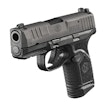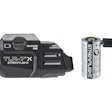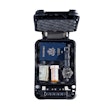Lewis Machine & Tool Co. has just introduced what may be the next evolutionary step in the ongoing development of the AR-15/M-16 family of rifles. Called the Monolithic Rail Platform (MRP), the rifle was designed to cure some ills common to this weapon system and provide some needed options. Featuring an innovative one-piece receiver/handguard system and quick barrel-change capability, the MRP is destined to find favor with SWAT officers.
According to Karl Lewis, owner of Lewis Machine & Tool (LMT), it was his ties to Special Forces that inspired him to design the MRP. These soldiers and their law enforcement counterparts needed a weapon that could stand up to serious abuse while maintaining its point-of-impact and point-of-aim. The problem in achieving this goal lies in the threads of the upper receiver.
For years we’ve been using free float handguards so point of impact will not change whether we shoot from a sandbag rest, use a bipod, or just adjust our sling tightly. But even this system is not foolproof. With sustained fire, the threads can heat up to between 400 and 500 degrees Fahrenheit. At this point, the receiver’s tensile strength changes and the tension becomes inconsistent. The substantial heating of the gun results in a change to the point-of-impact.
The usual sequence goes something like this. The operator sights his gun in and everything is fine for the first few magazines. But as repeated firing creates substantial heat, the groups start opening up and the point-of-impact changes. Perplexed, the soldier returns the rifle to the armorer for inspection. After carefully scrutinizing the now-cool rifle and finding nothing wrong, the armorer will sometimes tighten the barrel nut a little more and return the rifle. Back at the range, the process repeats itself.
Innovative Solution
Lewis’ solution to this problem was to take Eugene Stoner’s M-16 design and eliminate the receiver’s threads. Since the handguards are integral to the receiver, there’s no barrel nut — at least in the conventional sense.
Looking at the gun, you’ll see two Torx-head screws on the bottom of the upper receiver near the lower’s hinge pin. When the two receiver bolts are tightened, the circumference of the MRP tightens all the way around the barrel, leaving no gaps. The notch and bolt align the barrel perfectly and consistently, so it is completely free floating. This system eliminates the loss of zero caused by the weak connection properties of aluminum barrel retention threads. It’s interesting to note that this system also transfers less heat to the handguard area.
No special equipment is needed to install the barrel other than a T30 Torx wrench. To switch barrels, the user simply loosens the two Torx screws, removes the barrel and slides the new one in and retightens the screws. Lewis’s system is well thought out.
My concern was twofold before I examined the rifle. Would the barrel index consistently and return to the same point-of-aim? Is it possible for the headspace to change? Lewis machines a groove in the bottom of the barrel extension, which the forward screw engages, and this indexes the barrel once tightened. There’s a headspace collar that’s affixed to the barrel that ensures consistency and also supports the gas tube. In fact, it’s virtually impossible to assemble the barrel to the receiver in a way that will provide inconsistent headspacing or indexing.
The MRP doesn’t just offer the ability to change barrel lengths quickly; it also provides a system that will allow the user to switch caliber. 5.56 x 45mm, 5.45 x 39mm, 6.8 x 43mm, and 7.62 x 39, and .204 Ruger are all supported by this system. But keep in mind that the bolt carrier needs to be changed if the casehead diameter is different.
Dwell on This
Speaking of bolt carriers, Lewis has also designed a new and improved bolt carrier system that is available for the MRP, as well as for standard rifles and carbines. The United States military has run into problems with the new M-4 carbine and its unexpectedly short service life. Most are of the opinion that the dwell time is too short and the increased pressure causes the gun to beat itself up.
Dwell time is defined as the time between the round being fired and when the bolt unlocks and starts the extraction and ejection portion of the cycling sequence. With the shorter gas tube, the gas acts on the bolt carrier much faster than the rifle: 7.5 inches from the chamber versus 13 inches for the rifle. In addition to acting on the carrier more quickly, the gas pressure acting on the carrier is nearly twice as much as the rifle. This manifests itself into extraction problems, as well as high stresses on all of the components due to increased bolt carrier velocity.
Lewis has increased the length of the cam path to greatly increase dwell time. Material was added to the front of the carrier, which fits into the feed ramp chamber, which will allow both standard and enhanced bolts to be used. This modification gives the carbine or rifle more time for the pressure to drop before the bolt unlocks. All of these features are patent pending.[PAGEBREAK]
Details
The MRP starts as an eight-pound billet of aluminum. After five hours of CNC machine time it weighs just 1.47 pounds when finished. LMT offers two versions of the MRP: the rifle upper for use with barrels 18 inches and longer and the CQB (this is the one tested), which can be used with barrel lengths of 10.5, 14.5, and 16 inches. Barrels can be had in both chrome-lined and stainless-steel configurations and are rifled with a 1:7 inch twist. Because of the indexing groove cut on the bottom of the barrel extension, only LMT barrels can be used with the MRP.
Since the receiver also includes an integral handguard, the upper portion of the MRP CQB features 16.5 inches of continuous Picatinny rail. Optics, lasers, night vision equipment, lights, a vertical foregrip, and a bipod can all be added to the carbine via the rail system. LMT hard coat anodizes the upper receiver to milspec. The rail grooves are also numbered so equipment that has been detached can be quickly reattached in the same position it was last used. The numbers are in white and easily visible with night vision goggles.
My test sample came equipped with LMT’s detachable sights. The rear sight, which affixes to the Picatinny rail by means of a single thumbscrew, is adjustable for both windage and elevation. It looks very much like the detachable carry handle sight used on the M4 with the carry handle machined away. The front sight also attaches with a thumbscrew. Since I was more interested in the carbine’s mechanical accuracy, I mounted a Trijicon 1.25 x 4 Accupoint scope for the accuracy portion of the evaluation.
Shooting Impressions
I did all of my shooting from a seated position using a rest on top of a cement benchrest. Because I do not have the proper licensing for a Short Barreled Rifle (SBR), I had to rely on the folks at Lewis Machine and Tool for velocities and accuracy from the 10.5-inch and 14.5-inch barrels.
As you can see from the accuracy charts, the MRP system is phenomenally accurate. Who would have ever guessed that a 10.5-inch barrel would be capable of sub-1⁄2 MOA accuracy? LMT’s MRP CQB possesses far more accuracy than most heavy barreled counter-sniper weapons. All of the groups were fired from a hot barrel without allowing for any substantial cooling time.
Switching from the 16-inch, chrome-lined barrel to the stainless steel barrel, the point of impact changed. I had to adjust the scope four inches left and add about seven inches of elevation. This change was not unexpected and for someone that anticipates using more than one barrel it would be a good idea to keep notes. After shooting my groups with the stainless barrel I reinstalled the chrome-lined barrel and found that it shot to the original point of impact. While it was boringly accurate to shoot from the bench, I also wanted to see how the carbine would perform during some rapid-fire exercises.
I set up some steel targets, about 14x14 inches at 50 yards, and was able to double tap them with ease. My friend, Frank Grijalva, accompanied me on this trip. Frank was a Fighting C.B. during Vietnam and has the scars to prove it. After being shot through the lungs and spending 14 months in military hospitals, the Navy declared him fit and discharged him. He spent the next 30 years in law enforcement. Although he is familiar with the M-16 and AR-15 weapon systems, the MRP was unlike anything he’d ever been exposed to. Despite this, he was able to hammer the steel targets with ease, making quick decisive hits. I think that he was most impressed with the scope and the glowing amber aiming point.
One thing that makes the MRP carbine easy to shoot is its SOPMOD (Special Operations Peculiar Modification) stock. LMT supplies all of the U.S. Military branches with this slick five-position collapsible stock. Its design, a wide wedge shape, provides the most comfortable cheek weld of any collapsible design that I’ve ever used. It fits my crooked face perfectly.
The SOPMOD features two watertight battery storage compartments so the operator can always have a fresh supply of batteries. It also has a rubber buttplate that makes shooting the rifle comfortable and also keeps the butt from slipping off the shoulder…even against slick nylon web gear or body armor. And unlike most of the collapsible stocks that I’ve had experience with the SOPMOD is 100-percent rattle free. LMT also supplies textured rail covers with the MRP to make handling the carbine more comfortable when the rails aren’t needed for attachments.
Lewis Machine & Tool has been building weapon systems for the military and producing parts for many American firearms manufacturers for more than 25 years. This experience shows in the design and quality of the Monolithic Rail Platform. Although the military and law enforcement have very different missions, both need a weapon that can stand up to serious abuse and sustained fire without its point-of-impact changing. The MRP is the best solution that I’ve seen to this problem thus far.
Because of the numerous configurations and options that LMT offers it’s almost impossible to quote a firm price, but the company does offer a law enforcement discount. MRP uppers are also available for separate purchase and will fit any milspec AR-15 lower.
Mike Detty is an NRA-certified rifle, pistol, and shotgun instructor. A certified rangemaster and competition shooter, Detty served as an officer in the U.S. Marine Corps and holds a degree in criminal justice from the University of Arizona.














